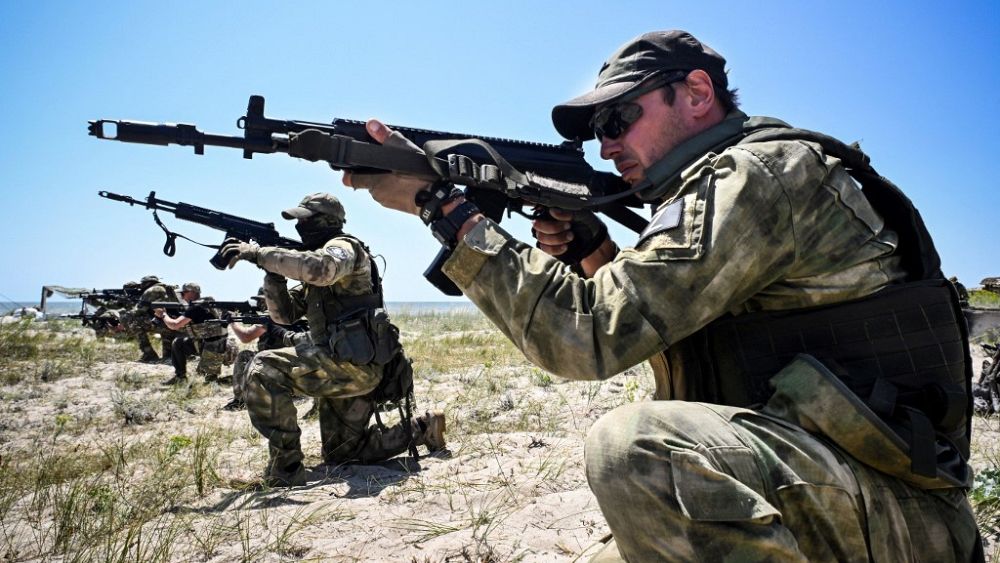
All the latest developments from the war in Ukraine.
Ukrainian missiles rain down on Russian front
Kyiv launched an array of missiles against Russia’s “entire front”, the Institute for the Study of War (ISW) said on Wednesday.
Russian facilities across the war front were targeted by coordinated missile attacks, according to several geolocated footage and images.
The US-based think tank’s analysis confirmed strikes in a Russian military facility in Makiivka and an administration building in the occupied territory of Volnovakha.
“Ukrainian forces launched a coordinated series of strikes aimed at degrading Russian logistics and ground lines of communication (GLOCs) throughout the theatre,” the ISW said.
The analysis comes amidst Ukraine’s Security and Defence Council secretary’s claims of “fruitful” counteroffensive efforts in the past few days.
Ukraine has ramped up its efforts to regain occupied territories towards the east as a fierce battle continues near Bakhmut.
Washington willing to send cluster bombs to Ukraine
The United States is willing to send cluster munitions to Ukraine to help its military dislodge and push back entrenched Russian forces.
A new military aid package worth €735 million is expected to be announced by the Biden administration on Friday, people familiar with the decision told AP news agency on condition of anonymity.
The move comes after Ukrainian President Volodymyr Zelenskyy claimed slow weapons deliveries to Ukraine are frustrating its counteroffensive, allowing Russia to strengthen in occupied areas with mines.
Sending the banned ammunition to Kyiv is expected to trigger outrage from some allies and humanitarian groups that have long opposed the use of cluster bombs.
Cluster munitions are an attractive option because they would help Ukraine destroy more targets with fewer rounds.
The use of cluster bombs itself does not violate international law, but using them against civilians can be a violation.
A convention banning the use of cluster bombs has been joined by more than 120 countries, which agreed not to use, produce, transfer or stockpile the weapons and to clear them after they’ve been used.
The US, Russia and Ukraine haven’t signed the agreement.
The US hasn’t used them in conflict since Iraq and it has large amounts of them in storage it can access quickly, said Ryan Brobst, a research analyst for the Foundation for Defense of Democracies.
Proponents argue that Russia has already been using the controversial weapon in Ukraine and that the munitions the US will provide have far fewer unexploded rounds that can result in unintended civilian deaths.
NATO tracking Wagner mercenaries, says Stoltenberg
NATO is monitoring the movement of Wagner mercenaries and chief Yevgeny Prigozhin, the Western military alliance’s chief said on Thursday.
Jens Stoltenberg’s comments come after the Belarusian President claimed exiled Wagner boss is not in Belarus.
“We monitor closely where the Wagner soldiers are moving around, and also where he [Prigozhin] is moving,” Jens Stoltenberg told news outlet Al Jazeera.
Contrary to the deal that ended Wagner’s mutiny against the Russian military leadership, the mercenaries have not moved to Belarus in large numbers, according to Stoltenberg.
“We have seen some preparations for hosting large groups of Wagner soldiers in Belarus. So far we haven’t seen so many of them going to Belarus,” he said.
Stoltenberg claimed Prigozhin was “moving a bit around” refusing to go into details.
The Wagner boss reportedly arrived in Belarus just over a week ago upon Alexander Lukashenko’s invitation.
“He’s in St Petersburg. He is not on the territory of Belarus,” Lukashenko told reporters on Thursday.
THE ROTTEN FISH: CAN OF WORMS OPENED OF APC & TINUBU'S GOVERNMENT OVER NIGERIA'S ECONOMIC DOWNTURN
WATCH THE CRITICAL ANALYSIS AND KNOW THE RESPONSIBLE PARTIES TO BLAME FOR NIGERIA'S ECONOMIC CHALLENGES, WHILE CITIZENS ENDURE SEVERE HARDSHIPS.Watch this episode of ISSUES IN THE NEWS on 9News Nigeria featuring Peter Obi's Special Adviser, Dr Katch Ononuju, 9News Nigeria Publisher, Obinna Ejianya and Tinubu Support Group Leader, McHezekiah Eherechi
The economic crisis and hardship in Nigeria are parts of the discussion.
Watch, leave your comments, and share to create more awareness on this issue.
#9NewsNigeria #Nigeria #issuesInTheNews #politics #tinubu THE ROTTEN FISH: CAN OF WORMS OPENED ...
DON'T FORGET TO SUBSCRIBE AND LEAVE YOUR COMMENTS FOR SUBSEQUENT UPDATES
#9newsnigeria #economia #economy #nigeria #government @9newsng
www.9newsng.com
